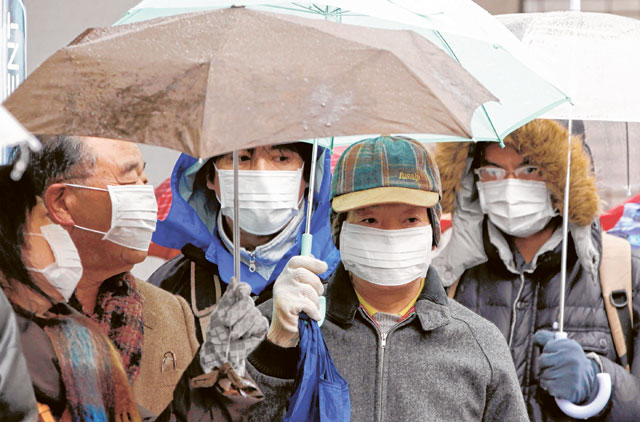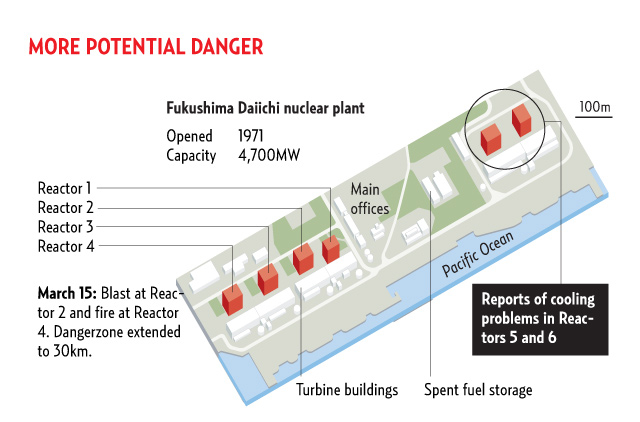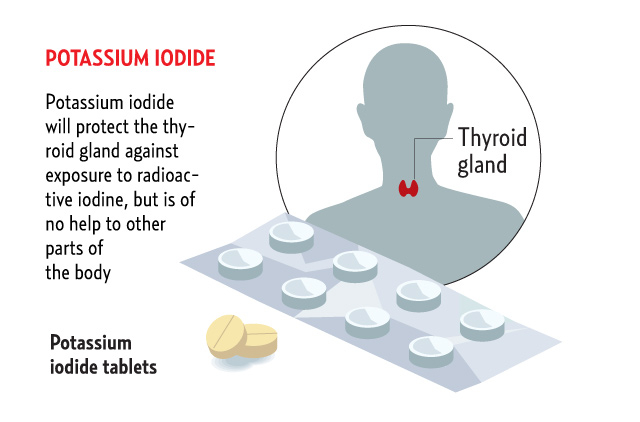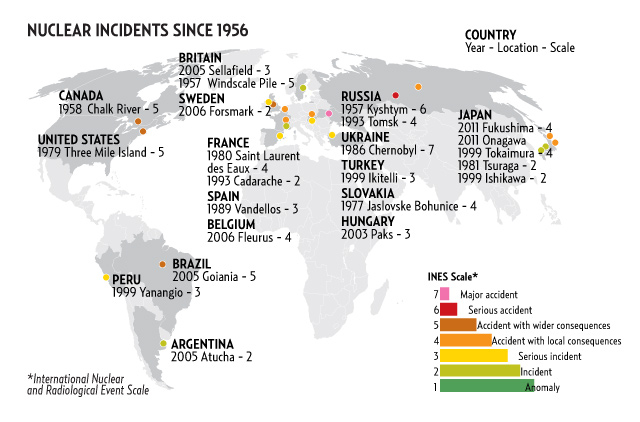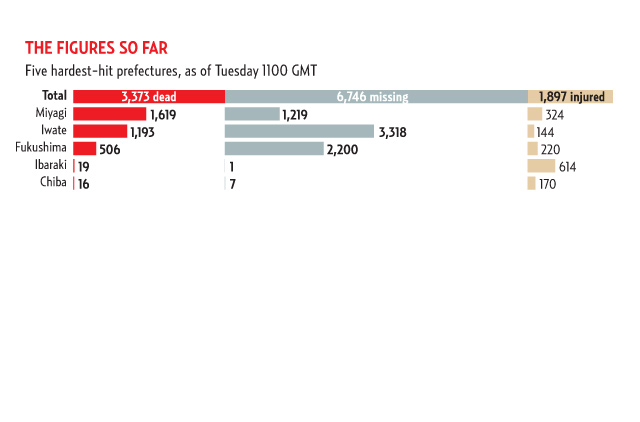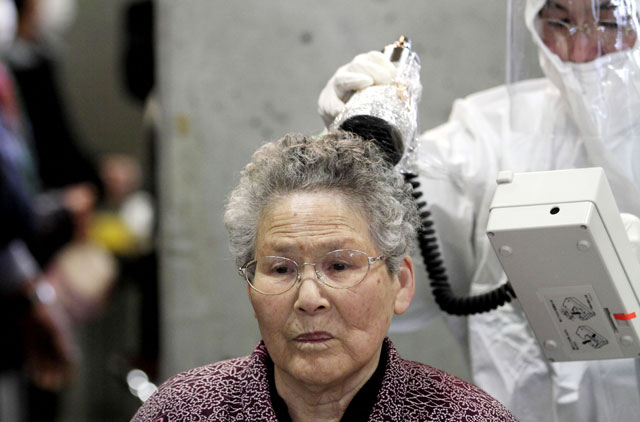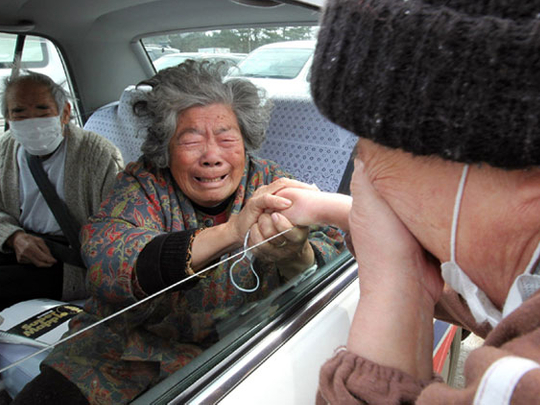
Tokyo: Special Japanese military fire trucks on Thursday unleashed jets of water on a damaged reactor at the quake-hit Fukushima nuclear power plant, public broadcaster NHK reported. Two trucks deployed by Japan's Self-Defence Forces were working at the Fukushima No.1 plant, 250 kilometres (155 miles) northeast of Tokyo, NHK said. The military has sent a total of five trucks to the scene.
Interactive: Japan's quake, tsunami, and nuclear threat
In pictures: Quake damage in Japan
Meanwhile, Taiwan authorities have detected radioactive particles on 25 passengers arriving on planes from Japan, where one of the worst nuclear crises in history is unfolding, officials said Thursday.
A day after scanning equipment was set up at three major airports, more than 4,400 people arriving from Japan had been tested and 25 were found to carry radioactive particles, said the Atomic Energy Council, Taiwan's nuclear regulator.
"Most of the radioactive particles were discovered on their shoes or clothes," an official said. All were allowed to leave after they had changed shoes or clothes or had the affected items washed with water, he said.
Radioactive particles heading for North America
Low concentrations of radioactive particles are heading eastwards from Japan's disaster-hit nuclear power plant towards North America, a Swedish official said.
Lars-Erik De Geer, research director at the Swedish Defence Research Institute, a government agency, was citing data from a network of international monitoring stations.
He stressed that the levels were not dangerous for people.
Food screened for radioactivity
Japan instructed local authorities on Thursday to start screening food for radioactivity after accidents at an earthquake-hit nuclear power plant sparked fears of wider contamination.
It is the first time Japan has set radiation limits on domestically produced food, a health ministry official said.
The limits are in line with an anti-disaster programme prepared in advance by the government's atomic power safety commission, said the official.
Limits vary depending on the type of foodstuff but have been set in consultation with internationally accepted levels and average intake in the Japanese diet.
Radioactivity leaked into the air after explosions at the Fukushima No.1 plant, where last week's quake and tsunami knocked out the reactor cooling systems.
Several Asian nations have said they will screen food imported from Japan for radiation while the European Union has called for similar checks.
Japanese choppers dump water on stricken reactor
Operators of a quake-crippled nuclear plant in Japan dumped water on overheating reactors on Thursday while the United States expressed growing alarm about leaking radiation and urged its citizens to stay well clear of the area.
While Japanese officials were scrambling to contain the nuclear crisis with a patchwork of fixes, the top US nuclear regulator warned that one reactor cooling pool for spent fuel rods may have run dry and another was leaking.
"There is no water in the spent fuel pool and we believe that radiation levels are extremely high, which could possibly impact the ability to take corrective measures," Gregory Jaczko, head of the Nuclear Regulatory Commission, told a US House Energy and Commerce subcommittee hearing.
"It would be very difficult for emergency workers to get near the reactors. The doses they could experience would potentially be lethal doses in a very short period of time."
Obama talks with Japan PM on nuclear threat
US President Barack Obama has spoken with Japanese Prime Minister Naoto Kan about steps the US is taking to ensure the safety of Americans in Japan - measures that go beyond what Japan has recommended for its own citizens.
The White House says Obama and Kan spoke by phone Wednesday evening about the crisis at a Japanese nuclear power plant that's emitting dangerous levels of radiation after it was damaged in an earthquake and tsunami.
A White House statement said the two leaders' emphasized their alliance and discussed what the US is doing to ensure welfare of its citizens.
US officials took pains not to criticise the Japanese government, which has shown signs of being overwhelmed by the crisis, but Washington's actions indicated a divide with the Japanese about the perilousness of the situation.
Japan said the United States would fly a high-altitude drone over the stricken complex to gauge the situation, and had offered to send nuclear experts to help with the crisis.
Health experts said panic over radiation leaks from the Daiichi plant, around 240 km (150 miles) north of Tokyo, was diverting attention from other life-threatening risks confronting survivors of last Friday's 9.0 magnitude earthquake and tsunami, such as cold weather and access to fresh water.
The head of the world's nuclear watchdog said it was not accurate to say things were "out of control" in Japan, but the situation was "very serious", with core damage to three units at the plant.
However, Sebastian Pflugbeil, president of the private German-based Society for Radiation Protection, said Japan's efforts to pull the Fukushima plant back from the brink signalled "the beginning of the catastrophic phase".
"Maybe we have to pray," he said, adding that a wind blowing any nuclear fallout east into the Pacific would limit any damage for Japan's 127 million people in case of a meltdown or other releases, for instance from spent fuel storage "ponds".
The latest images from the plant showed severe damage to some of the buildings after several explosions.
Markets swoon, G7 ministers to hold emergency call
A stream of gloomy warnings and reports on the Japan crisis from experts and officials around the world triggered a swoon in US financial markets, with all three major stock indexes slumping on fears of slower worldwide growth.
Japan pumped more emergency funds into its buckling financial system Thursday after the safe-haven yen hit a record high and shares slid, as authorities fought to stabilise a stricken nuclear plant.
The central bank injected another five trillion yen ($63 billion), increasing to 33 trillion yen the total amount of funds added to money markets since Monday to soothe jitters after last week's huge earthquake and tsunami.
In a sign of the degree of concern among top policymakers, one G7 central banker, who asked not to be identified, said he was "extremely worried" about the wider effects of the crisis in Japan, the world's third-largest economy.
"I think the world economy is going to go right down and it has happened at a time when financial markets are still very fragile," he said.
G7 finance ministers will hold a conference call later on Thursday to discuss steps to help Japan cope with the financial and economic impact of the disaster, a source said.
The yen surged to a record high against the dollar on market speculation Japan would repatriate funds to pay for the massive cost of post-disaster reconstruction. The yen rose as high as 76.25 per dollar , surpassing the previous record high of 79.75 reached in the wake of the Kobe earthquake in 1995. Japanese Finance Minister Yoshihiko Noda blamed speculation for the yen's surge and repeated his warning that he would closely watch market action.
Bid to get power restored
Japan's nuclear agency said radiation levels at the plant "continued to fall", but the government appealed to private companies to help deliver supplies to tens of thousands of people evacuated from a 30-km (18-mile) zone around the complex.
Tokyo Electric Power Co. (TEPCO) officials said bulldozers attempted to clear a route to the reactor so fire trucks could gain access and try to cool the facility using hoses.
Company officials also said they had high hopes of getting limited power to the facility to help pump water needed to cool reactors and the spent fuel rods that have been overheating, but not yet for reactors considered most at risks, No. 3 and 4.
High radiation levels on Wednesday prevented a helicopter from dropping water into No. 3 to try to cool its fuel rods after an earlier explosion damaged its roof and cooling system.
Another attempt on Thursday appeared to be partially successful, with two of four water drops over the site hitting their mark.
The plant operator described No. 3 - the only reactor at that uses plutonium in its fuel mix - as the "priority". Experts described plutonium as a very nasty isotope that could cause cancer if very small quantities were ingested.
The situation at No. 4 reactor, where the fire broke out, was "not so good", TEPCO added, while water was being poured into reactors No.5 and 6, indicating the entire six-reactor facility was now at risk of overheating.
Embassies urge citizens to leave
Scores of flights to Japan have been halted or rerouted and air travellers are avoiding Tokyo for fear of radiation.
On Thursday, the US embassy in Tokyo urged citizens living within 50 miles (80 km) of the Daiichi plant to evacuate or remain indoors "as a precaution", while Britain's foreign office urged citizens "to consider leaving the area".
The warnings were not as strong as those issued earlier by France and Australia, which urged nationals in Japan to leave the country. Russia said it planned to evacuate families of diplomats on Friday.
At its worst, radiation in Tokyo has reached 0.809 microsieverts per hour this week, 10 times below what a person would receive if exposed to a dental x-ray. Early on Thursday, radiation levels were barely above average.
But many Tokyo residents stayed indoors, usually busy streets were nearly deserted and many shops and offices were closed.
The plight of hundreds of thousands left homeless by the earthquake and tsunami worsened following a cold snap that brought snow to worst-affected areas.
Supplies of water and heating oil are low at evacuation centres, where many survivors wait bundled in blankets.
About 850,000 households in the north were still without electricity in near-freezing weather, Tohuku Electric Power Co. said.
Global qualms
In a demonstration of the qualms about nuclear power that the crisis has triggered around the globe, China announced that it was suspending approvals for planned plants and would launch a comprehensive safety check of facilities.
China has about two dozen reactors under construction and plans to increase nuclear electricity generation about seven-fold over the next 10 years.
Russia said nuclear power was safe provided power stations were built in the right place and designed and managed properly, but ordered checks at nuclear facilities.


